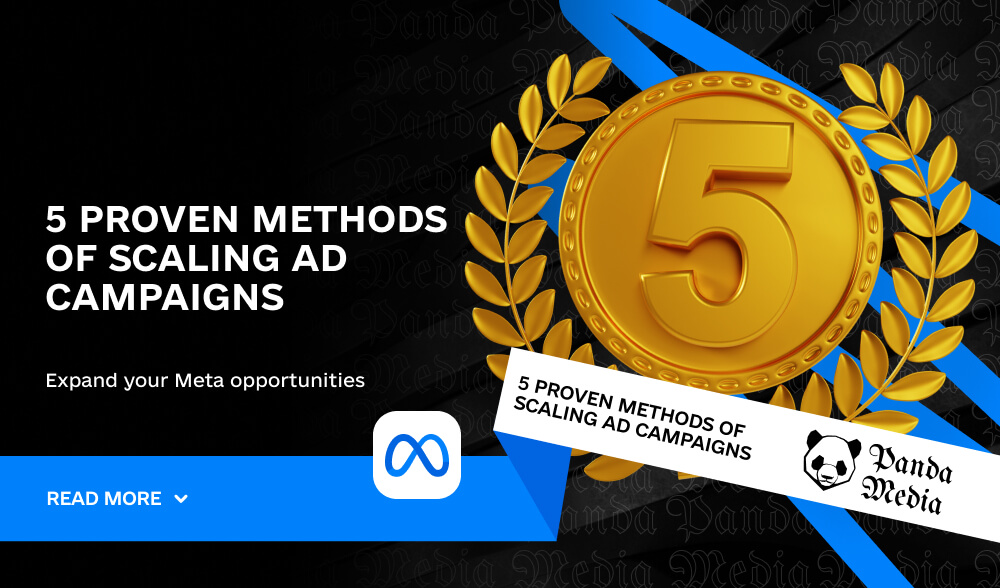Don't miss interesting news

Interested in expanding your Facebook and Instagram ad campaigns? This is often a challenging task. It is important to note that expanding campaigns on Meta is not only about increasing the budget and tracking results, but also about steadily increasing costs while maintaining the set performance indicators.
Whether you’re looking to reduce your cost per action (CPA) or increase your return on advertising spend (ROAS), the techniques below will help you increase your budget and boost these key metrics. Read on for our analysis of 5 proven methods and successfully scale your ad campaigns.
This method requires that you have been using broad targeting for some time and noticed a decrease in its effectiveness. If you haven’t done so, the first step is to launch a new campaign to find your audience. Enable the appropriate geographic and demographic parameters, choose automatic placement, upload your most effective creatives, and give the campaign a few months to collect data.
If you already have a significant amount of data, you can move on to the next step. First, break down all your campaigns by age, gender, region, and platform. To do this, click the “Breakdown” button in the upper right corner of the manager and select the desired criterion. Next, analyze the results and highlight the best attributes by ROAS, excluding those with too little spend to draw conclusions.
For example, if it turns out that women perform better than men, the 25-45 age group is better than others, Instagram is more effective than Facebook, and some regions outperform others, mark these attributes and create a new campaign based on the successful audience segments you analyzed.
Tip: When choosing segments, make sure the group is broad enough, for example, by age and region, to avoid being too narrow. Avoid selecting only the top two or three regions, as too narrow an audience will make it difficult to scale and degrade performance. Aim for an audience of at least 3 million people.
The goal is to direct Meta funds to an audience that has already demonstrated good results. This campaign targets the top 30-50% of users. Creating this campaign separately will also allow for better budget control, providing more flexibility to scale and improve results compared to other campaigns.
The effectiveness of advertising campaigns largely depends on creativity. If your advertising budget exceeds $1,000 per month, but your creatives are updated only once a quarter, this can make it difficult to scale and lead to a lack of growth in CPA and ROAS.
It’s best to let your creative evolve as your budget increases. Don’t just increase spending every week or month, updating creatives once a quarter.
! The general principle is that the number of creatives should double when the budget increases by 50%. For example, in the first month you spend $1,000 on 5 videos. By increasing your spending to $1,500 per month by the third month, you should have 10 videos.
In addition, once you reach $1500 and 10 videos, we recommend updating your creatives every 2 weeks or once a month. We consider advertising creatives as fuel: to keep moving forward, you need to constantly replenish your stocks.
Avoid significant changes in daily spend in a short time. When increasing the daily budget, you need to take into account the convenience for the pixel and the algorithm. If you change budgets abruptly, the algorithm may go back to learning. Therefore, we recommend a gradual increase in moderate steps.
Example: if you spend $100 per day and are satisfied with the results, start increasing your budget by 10% every two days. If the results remain stable or grow, after a few weeks you can try increasing your budget by 20% every few days. It’s important not to make more than two daily budget changes exceeding 20% within 24-48 hours.
Tip: Don’t adjust your budget several times a day and don’t react sharply to changes in daily performance. Instability is a normal phenomenon. Frequent budget changes can lead to additional volatility and return of ad sets to the training mode, which will negatively affect the results.
If your ad account consists of one large campaign with different ad sets for proven and new audiences/creatives, you should split them into separate campaigns.
Despite the ability to control the budget and pixel status at the ad set level, the best results can be achieved by splitting campaigns. It is important to find a balance between algorithm control and experimentation.
Allocate about 70% of your monthly budget to proven campaigns, leaving 30% for experiments. This will allow you to gain experience and reduce the impact of unsuccessful experiments on the algorithm.
If a successful variant appears in the experimental campaign after three months, move it to a stable category and repeat the cycle with new experiments. Typically, 1-3 elements are tested per month, including audiences, creatives, and landing pages, depending on the budget.
If you’ve already tried several of the methods described above, but are still facing failures and rising CPA or ROAS values, it may be worth changing your campaign goal.
Often, campaigns are targeted at conversions, such as sales or leads. While this is usually effective, sometimes an offer can be special and require a different approach. In such cases, you can allocate a portion of the budget (approximately 10-20%) to campaigns with other goals, such as engagement, traffic, or awareness.
For example, you can launch a campaign with the goal of “Reach” by allocating 10% of the monthly budget for video ads. This way, your ads will be shown to a new audience at a lower CPM, which can be 80% cheaper than the CPM for conversions. These users who have watched more than 50% of your video can then be retargeted in subsequent campaigns.
Expanding your Facebook and Instagram ad campaigns is an asterisked task. Implement the scaling methods we’ve outlined and get more without losing. We are always ready to support you!